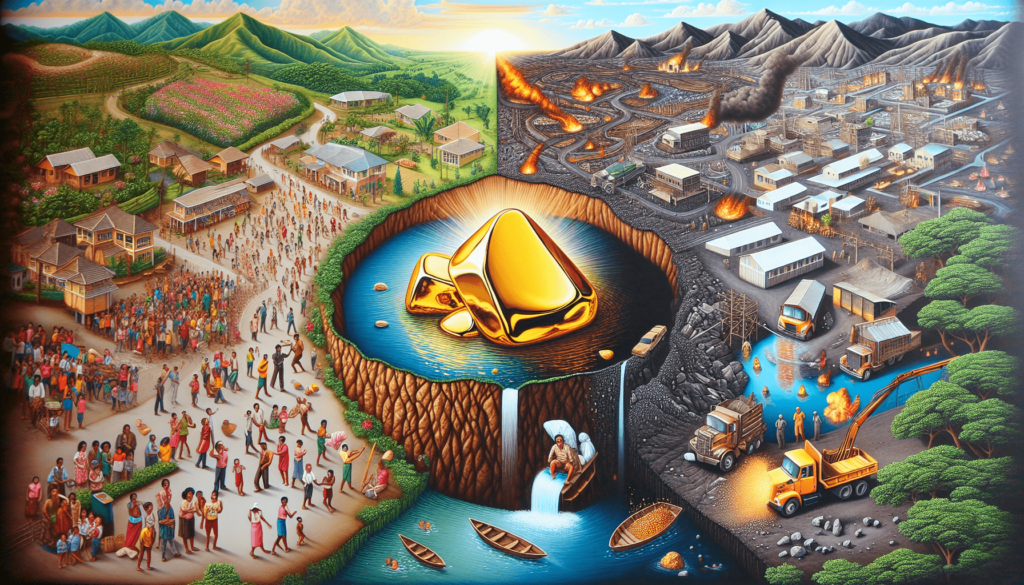Gold mining has long been associated with glamour and luxury, depicted as a symbol of opulence and wealth. However, beneath the shimmering surface, lies a complex reality that often goes unnoticed. In this article, we explore the impact of gold mining on local communities. From environmental degradation to social and economic consequences, we will delve into the multifaceted effects that this precious metal has on the very communities it originates from. So buckle up and prepare yourself for a journey into the lesser-known aspect of the gold industry.

Environmental Impact
Deforestation
Gold mining often leads to severe deforestation in local communities. The clearing of forests reduces habitat for numerous species and disrupts ecosystems. It not only affects wildlife but also deprives local communities of essential resources that forests provide, such as clean air, water, and food.
Water Pollution
Gold mining involves the use of toxic chemicals like cyanide and mercury, which are released into nearby water sources during the extraction process. This pollution contaminates rivers, streams, and groundwater, posing a severe threat to aquatic life and the health of local communities who depend on these water sources for their daily needs.
Erosion
The process of gold extraction requires significant land disturbance, leading to erosion of the topsoil. This erosion not only affects the fertility of the land but also leads to sedimentation in nearby water bodies. Excessive sedimentation can disrupt aquatic ecosystems and make it challenging for fish and other organisms to survive.
Loss of Biodiversity
Gold mining activities often result in the destruction of habitats and the displacement of plant and animal species. Loss of biodiversity is a significant consequence as it disrupts the delicate balance of ecosystems and can lead to the extinction of vulnerable and endemic species. Local communities depend on biodiversity for food, medicinal plants, and cultural practices, making its loss particularly devastating.
Health and Safety Concerns
Exposure to Toxic Chemicals
Gold mining involves the use of toxic chemicals like cyanide and mercury, which pose severe health risks to miners and nearby communities. Workers and residents exposed to these chemicals can suffer from long-term health issues such as neurological problems, kidney damage, and various forms of cancer.
Respiratory Issues
The extraction and processing of gold often release fine particulate matter into the air, causing respiratory problems for miners and local residents. Prolonged exposure to dust and airborne pollutants can lead to chronic respiratory conditions like asthma, bronchitis, and silicosis.
Mercury Poisoning
Mercury is commonly used in small-scale gold mining to extract gold from ore. However, the improper handling and disposal of mercury-contaminated waste can lead to mercury pollution in the environment. This pollution can enter the food chain, causing mercury poisoning in both humans and wildlife.
Occupational Hazards
Gold mining is a dangerous profession, and miners are exposed to numerous hazards on a daily basis. Cave-ins, explosions, and accidents with heavy machinery are common risks faced by miners, often resulting in severe injuries or even fatalities. Lack of proper safety equipment and training further compounds these dangers.
Economic Effects
Job Creation
Gold mining can generate employment opportunities in local communities, providing much-needed jobs for individuals who may otherwise struggle to find work. These jobs help alleviate poverty and improve the livelihoods of individuals and their families.
Income Generation
Gold mining contributes to income generation by providing miners with wages and local businesses with increased economic activity. This income allows families to access essential services, invest in education, and improve their standard of living.
Dependency on Gold
However, the reliance on gold as a primary source of income can lead to economic vulnerability and instability. Fluctuating gold prices and market demand can profoundly impact local economies, leaving communities susceptible to economic downturns.
Inflation
The influx of wealth from gold mining can drive inflation in local communities. As more money enters the economy, the cost of goods and services can rise, making it challenging for everyday people to afford basic necessities. This inflation can further exacerbate existing socioeconomic disparities.
Social Consequences
Community Displacement
Gold mining operations often require large areas of land, resulting in the forced displacement of local communities. This displacement can disrupt established social structures, lead to the loss of ancestral lands, and create significant hardships for affected individuals and families.
Conflict and Violence
The presence of gold in an area can spark conflicts and disputes over mining rights, leading to violence and civil unrest. Such conflicts can have devastating consequences for local communities, including loss of life, destruction of infrastructure, and erosion of social cohesion.
Human Rights Violations
Gold mining operations have been associated with various human rights violations, including forced labor, child labor, and other exploitative practices. Miners, particularly those in informal and artisanal mining sectors, are often subjected to hazardous working conditions and are denied fair wages and basic labor rights.
Child Labor
Child labor is a prevalent issue in many gold mining communities. Children are often engaged in hazardous work, risking their health and well-being. They are deprived of education and are trapped in a cycle of poverty that perpetuates their exploitation.

Cultural Impact
Cultural Disintegration
The influx of mining operations can disrupt traditional cultural practices and threaten the preservation of cultural heritage. Indigenous communities, who often have deep cultural connections to the land, may face the loss of their identity and spiritual connection through the destruction of sacred sites and disruption of their way of life.
Loss of Traditional Practices
Gold mining can undermine traditional livelihoods and practices such as subsistence farming, hunting, and gathering. This loss of traditional practices can lead to a loss of self-sufficiency and further dependency on the mining industry, perpetuating the cycle of environmental and social degradation.
Language and Identity
Mining activities often bring outsiders to local communities, leading to the introduction of new languages and cultural norms. This can contribute to the erosion of local languages and traditions, jeopardizing the unique cultural identity of the affected communities.
Corruption and Illegal Activities
Bribery and Fraud
Gold mining operations can be vulnerable to corruption, with officials demanding bribes or engaging in fraudulent practices. This corruption not only undermines the integrity of the mining sector but also leads to the mismanagement of resources and a lack of accountability.
Illegal Mining
Illicit or illegal mining is a prevalent issue in many gold-rich regions. These operations often operate outside the realm of legality, avoiding taxation and proper regulation. Illegal mining can have severe environmental and social consequences, as operators disregard safety regulations and exploitative practices thrive.
Money Laundering
The lucrative nature of the gold trade can attract money launderers who seek to conceal illicit funds by investing in the mining sector. Money laundering not only enables criminal activities but also perpetuates a cycle of corruption and undermines the integrity of the industry.
Smuggling
Gold smuggling is a significant concern, as it denies local communities and governments of revenues and leads to illicit trade networks. Smuggling also encourages the unregulated and unsustainable extraction of gold, exacerbating the negative impacts on the environment and vulnerable communities.
Infrastructure Development
Roads and Transportation
The establishment of mining operations may result in improved infrastructure, including the construction of roads and transportation networks. This infrastructure development can enhance connectivity, facilitate regional trade, and improve access to remote areas.
Access to Clean Water
Mining operations often invest in water infrastructure, such as dams or water treatment facilities, to ensure a stable water supply for both the mining activities and the local communities. This access to clean water is essential for drinking, sanitation, and irrigation purposes.
Education and Healthcare Facilities
Increased economic activity from gold mining can lead to investments in education and healthcare facilities. This investment can improve access to quality education for children and healthcare services for local communities, contributing to overall human development.
Electricity and Energy
Mining operations often require significant energy resources, resulting in investments in energy infrastructure. This can lead to improved access to electricity and energy services in the vicinity of the mining sites, benefitting both the mining operations and the local communities.
Artisanal and Small-scale Mining
Working Conditions
Artisanal and small-scale mining (ASM) provides livelihoods for countless individuals in resource-rich regions. However, these miners often work under hazardous conditions, lacking access to proper safety equipment, and facing numerous health and safety risks.
Poverty Alleviation
ASM can contribute to poverty alleviation by providing income-generating opportunities for marginalized and vulnerable communities. It allows individuals to escape the cycle of poverty and improve their standard of living through self-employment and small-scale entrepreneurship.
Formalization of the Sector
Formalizing the ASM sector can lead to improved working conditions, better health and safety standards, and increased environmental awareness. Formalization can also ensure fair access to mining resources and markets, contributing to sustainable development.
Supporting Local Economies
ASM can play a crucial role in supporting local economies by creating multiplier effects through increased economic activity. It can stimulate the growth of supportive industries and businesses, providing a boost to the overall local economy.
Government Regulations and Policies
Environmental Regulations
Government regulations and policies are vital in mitigating the negative environmental impacts of gold mining. Strict regulations can prioritize environmental protection, requiring miners to implement sustainable mining practices and minimize their ecological footprint.
Human Rights Frameworks
Governments must establish and enforce human rights frameworks to protect the rights of all individuals involved in the gold mining industry. This includes ensuring fair labor practices, eradicating child labor, and safeguarding the rights of indigenous communities and local populations.
Benefit Sharing Agreements
Governments should implement benefit sharing agreements to ensure that the wealth generated from gold mining is distributed equitably among all stakeholders, including local communities. These agreements can contribute to addressing socioeconomic disparities and promoting inclusive development.
Monitoring and Enforcement
Effective monitoring and enforcement mechanisms are essential to ensure compliance with regulations and prevent illegal activities within the gold mining sector. Governments should invest in robust systems that hold mining companies accountable for their environmental and social responsibilities.
Sustainable Mining Practices
Alternatives to Mercury Usage
Promoting and incentivizing the adoption of mercury-free alternatives in gold mining can significantly reduce the environmental and health impacts associated with mercury usage. Innovative technologies and practices, such as gravity concentration and cyanide-free extraction, should be encouraged and supported.
Waste Management
Proper waste management practices are crucial to minimize the environmental impact of gold mining. Measures should include the safe disposal and treatment of toxic chemicals, the responsible handling of mine tailings, and the rehabilitation of disturbed land to restore ecosystems.
Rehabilitation of Mining Sites
Rehabilitating mining sites after extraction is essential to restore ecosystems, promote biodiversity, and prevent soil erosion. Governments and mining companies should invest in comprehensive site restoration plans to rehabilitate degraded areas and ensure long-term sustainability.
Community Engagement
Effective community engagement is essential in promoting sustainable mining practices. Local communities should be involved in decision-making processes, provided with information about mining operations, and empowered to participate in the planning and monitoring of mining activities.
In conclusion, gold mining has wide-ranging impacts on local communities, encompassing environmental, health and safety, economic, social, cultural, corruption, infrastructure, and governance aspects. To minimize the negative effects and maximize the benefits, sustainable mining practices, stringent regulations, community engagement, and responsible governance are essential. Striking a balance between the economic opportunities provided by gold mining and the well-being of local communities and their environment is crucial for long-term sustainable development.

